1.
Introduction
Collective behaviors often appear in many classical oscillatory systems [1,4,7,17,18,25,27,29]. Recently, such classical synchronization dynamics has been extended to a quantum regime, and it is called quantum synchronization in literature. It is worthwhile mentioning from [19,20] that quantum synchronization has attracted many researchers in the quantum optics community due to its powerful applications in quantum information and quantum computing [8,14,15,16,21,28,33,34]. Among possible candidates describing quantum synchronization, we are interested in analytical studies on quantum synchronization via Wigner's formalism [30] that was first introduced by Wigner in 1932 in order to find quantum corrections to classical statistical mechanics. For the mathematical properties of the Wigner transform, we refer the reader to [32].
To set up the stage, we begin with the Schördinger-Lohe (SL) model [19]. Let ψj=ψj(t,x):R+×Rd→C be the wave function of the quantum system situated at the j-th node whose dynamics is governed by the Cauchy problem to the SL model:
where Vj=Vj(x):Rd→R is a time independent potential at the j-th node, κ denotes a (uniform) nonnegative coupling strength between nodes, and ⟨⋅,⋅⟩ is the standard inner product in L2(Rd).
Note that the Planck constant is assumed to be unity for simplicity. Like the classical Schrödinger equation, system (1) satisfies L2-conservation of the wave function ψj. We refer the reader to a recent review article [9] for the emergent dynamics of the SL model (1).
In this paper, we study the emergent dynamics of the Cauchy problem to the WL model with identical potentials:
subject to initial constraints:
First, we recall the following definition of the emergent dynamics as follows.
Definition 1.1. [3] System (2) exhibits complete aggregation if relative states tend to zero asymptotically.
In the sequel, we provide several comments on the Cauchy problem (2)–(3). First, the WL model (2) was first introduced in [3], and a priori asymptotic analysis has been studied only for the two-particle system with N=2. Second, one notices that (2) is equipped with the identical potential V for all i,j. In fact, potentials for the corresponding SL model (1) would be non-identical in general. However, for the simplicity of mathematical representation, identical potentials are considered in both [3] and our analysis of this work. Third, initial data are restricted to a suitable class. For (3)1, it is usually assumed for the classical Wigner equation so that conservation laws hold under the assumption. Precisely, it corresponds to the mass conservation for a classical Schrödinger equation (see Remark 1). Hence, it would be reasonable to employ (3)1. On the other hand, the assumption (3)2 does not appear in the study of the classical Wigner equation consisting of a single equation, whereas (2) contains N2 equations. Later, we will see from Corollary 1 that (3)2 guarantees the uniform L2-boundedness. We refer the reader to [5,6,10,11,13,22,23,26,35] for the Wigner and Wigner-type equations.
The main results of this paper are two-fold. First, we provide the complete aggregation dynamics of (2) in a priori setting. Under the assumptions (3) on initial data, we can find an invariant set whose center plays the role of an asymptotically stable fixed point (see Lemma 3.2). Then, we obtain the uniform-boundedness of the L2-norm of a solution to the WL model and show that the L2-norms of all relative states tend to zero (see Corollary 1). For details, we refer to Theorem 3.1 in Section 3.
Second, we provide a global existence theory of (2) combining the classical methods (fixed point theorem and semigroup theory) and exponential aggregation estimates. We highlight that this paper extends the results in [3] where the existence theory was not considered even for N=2, whereas a priori aggregation estimates were established only for N=2. For this, we first define a suitable function space X which is a subset of L2(R2d). Then, we recast the WL model as a first-order matrix-valued PDE on X and apply the fixed point theorem to show that the WL model admits a global mild solution. Furthermore, if more regularity assumptions on initial data are imposed, then we show tha a global classical solution can be obtained from the semigroup approach (see Theorem 4.1).
The rest of this paper is organized as follows. In Section 2, we introduce generalized Wigner functions and the WL distribution matrix, and study their elementary properties. We also review previous results for the WL model. In Section 3, we provide complete aggregation estimates for the WL model in a priori setting. In Section 4, we show the global existence of mild and classical solutions depending on the regularity of initial data. Finally, Section 5 is devoted to a brief summary of this paper and some remaining issues for a future work. In Appendix A, we summarize classical results on the semigroup theory to be used for the global solvability in Section 4.
Gallery of Notation: Throughout the paper, as long as there is no confusion, we simply use R2d instead of Rdx×Rdp or R2dx,p. Let f=f(x,p) and g=g(x,p) be two functions in L2(R2d). Then, the standard L2-inner product and the L2-norm are defined by
where ¯g(x,p) is the complex conjugate of g(x,p)∈C. We set the Fourier transform and its inverse transform as follows:
For a given real-valued function ψ with two set of variables x,y∈Rd, we define the Fourier transform in y variable as follows:
2.
Preliminaries
In this section, we introduce the N×N Wigner-Lohe (WL) distribution matrix associated with the SL model (1), and its governing model "the Wigner-Lohe model", and review the emergent behaviors of the 2×2 Wigner-Lohe model in [3].
2.1. The Wigner-Lohe distributon matrix
In this subsection, we show how the WL distribution matrix can be constructed from the SL model. For this, we first recall the generalized Wigner distribution and the pseudo-differential operator.
Definition 2.1. [3]
1. For any two complex-valued wave functions ψ,ϕ∈L2(Rd), the generalized Wigner distribution w[ψ,ϕ] is defined by
where ¯ψ is the complex conjugate of ψ.
2. For V∈L∞(Rd) and w∈L2(R2d), we define the pseudo-differential operator Θ[V] as
Remark 1. Below, we give several comments on the generalized Wigner distribution and the pseudo-differential operator.
1. The generalized Wigner distribution is complex conjugate symmetric in the sense that
2. For the case ψ=ϕ, two definitions (4) and (5) yield the standard Wigner function [12]:
Since w[ψ,ψ] coincide with the standard Wigner function, we simply denote
Moreover, one can easily verify that w[ψ] is real-valued.
3. The p-integral of w[ψ]=w[ψ,ψ] is the modulus square of ψ:
Moreover, the (x,p)-integral of w[ψ,ϕ] is the inner product of ψ and ϕ:
4. Since V is real-valued, one also has
In the following lemma, we provide several properties of Θ[V](w) in Definition 2.1.
Lemma 2.2. For f,g∈L2(R2d), one has the following relations:
Proof. (ⅰ) We use the change of variables:
to yield
(ⅱ) By the definition of Definition 2.1 and Fubini's theorem, we have
Remark 2. If we set f=u and g=¯u in Lemma 2.2, and recall Remark 2.2(4), then one has
This yields
This fact was used in [23] to show the conservation of L2-norm for the solution to the quantum Liouville equation, which can be considered as a special case of the WL model with κ=0.
2.2. Dynamics of the Wigner-Lohe distribution matrix
For a given ensemble of wave functions {ψj} which is a solution to the SL model (1), we set
Then, the evolution of the WL distributions {wij} is given by the following coupled system:
For the detailed derivation of (6), we refer the reader to [3]. Next, we show that system (6) admits conservation laws.
Lemma 2.3. Let {wij} be a solution to (6) which rapidly decays to zero at infinity. Then, one has
(i)ddt∫R2dwii(t,x,p)dxdp=0,t>0,i∈[N].
(ii)ddt∫R2dwij(t,x,p)dxdp=∫Rd(Vi(x)−Vj(x))wij(t,x,0)dx,t>0,i,j∈[N].
Proof. (ⅰ) It follows from (6) that
Now, we integrate (7) over (x,p)∈R2d and then use the zero far field assumption on wij and the second estimate of Lemma 2.3 to see
(ⅱ) For the second assertion, we follow a similar calculation in (ⅰ).
Remark 3. (i) Consider the linear Wigner equation:
Then by Lemma 2.3, one has
However, it is worthwhile mentioning that since w(t,x,p) can take negative values, the L1-norm of w would not be conserved in general. In fact, the relation (8) corresponds to the L2-conservation of the Schrödinger equation. If we assume that
for a solution ψ to the linear Schrödinger equation, then the following relation holds (see Remark 1 (3)):
Thus, the results in Lemma 2.3 is consistent with the classical theory for the Wigner equation.
(ii) It follows from Moyal's identity [31] that
Hence, the linear Wigner equation enjoys L2-conservation (but not L1-conservation).
(iii) We have shown in Lemma 2.3 that diagonal elements {wi} satisfy conservation laws. However the off-diagonal elements do not satisfy conservation laws. Hence, conservation laws hold for system (6) with identical potentials.
From now on, we are concerned with the following special situation:
In this case, the (x,p)-integrals of {wij} are constants along the dynamics (6) (see Lemma 2.3):
Hence, the Cauchy problem for system (6) with (9) can be further simplified as follows:
2.3. Previous results
In this subsection, we briefly recall the result from [3] for a two-body system. Extension to the many-body system will be discussed in the following two sections separately. We set
Then, (w1,w2,w12) satisfies the Cauchy problem:
subject to constraints:
Theorem 2.4. [3] Let (w1,w2,w12) be a solution to (11)–(12). Then, we have
where z_{12} is defined in (10).
Proof. (ⅰ) The first estimate follows from the following ODE:
This can be integrated explicitly:
where z_{12}^0 = z_{12}(0) . If we assume that
then the denominator of the right-hand side of (13) can be zero, and hence z_{12}(t) can blow up in finite-time. Precisely, there exists 0<T_* <\infty such that
In other words, for initial data satisfying (14), z_{12}(t) would not be bounded. Thus, \text{Re} z_{12}^0 should be not be small enough to prevent a finite-time blow-up, and such condition is realized as (12). Of course, condition (12) would not be optimal in the sense to guarantee the finite-time blow-up.
(ⅱ) It is easy to see that w_1-w_2 satisfies
We multiply (15) by 2(w_1-w_2) and integrate the resulting relation to obtain
Then, Grönwall's inequality and the first estimate |1-z_{12}(t)|\lesssim e^{-\kappa t} yield the desired second estimate.
Before we close this section, we introduce elementary estimates to be used in the following sections.
Lemma 2.5. Let y:\; \mathbb R_+ \to \mathbb R_+ be a {\mathcal C}^1 -function satisfying a differential inequality:
Then, the following assertions hold.
1. If \alpha_i and \beta_i satisfy
there exist uniform positive constants C_0 and D_0>0 such that
2. If \alpha_i and \beta_i satisfy
there exists a uniform constant C_1 such that
Proof. (ⅰ) By the comparison principle of ODE and method of integrating factor, we have
Hence, there exist uniform positive constants C_0 and D_0>0 such that
(ⅱ) We multiply (16) with the integrating factor
to find
3.
Uniformization of the Wigner-Lohe distribution matrix
In this section, we present complete aggregation estimates for (2)–(3) in a priori setting. Our first result can be stated as follows.
Theorem 3.1. Let w_{ij} be a sufficiently smooth solution to (2)-(3). Then, the complete aggregation emerges asymptotically:
Proof. Since the proof is rather lengthy, we introduce a strategy toward the proof. We first claim:
For this, the key idea is to derive Grönwall's type differential inequality for \sum_{k = 1}^N \|w_{ik}-w_{jk}\|^2 . To be more specific, we will show that there exist two positive constants C_1 and C_2 such that
Then, we apply Lemma 2.5 to derive the desired zero convergence for \|w_{ik} - w_{jk}\| . Finally, the triangle inequality gives the desired result:
The derivation of (18) will be given in Section 3.2 after some preparatory estimates in Section 3.1.
3.1. Preparatory estimates
In this subsection, we study basic estimates for (2)–(3) that will be used in the derivation of (18). We set
Then, it follows from Lemma 2.3 that
On the other hand, we integrate (2) with respect to (x, p)\in \mathbb R^{2d} to find the finite-dimensional dynamics for z_{ij} :
Due to (19), it is natural to consider the maximal diameter for the set \{ 1-z_{ij} \} :
which is expected to converge to zero under a suitable condition.
Lemma 3.2. (Existence of a positively invariant set) Let \{w_{ij}\} be a solution to (2)-(3) satisfying the relation:
Then, one has
Proof. It follows from (20) that
Then, (22) gives
where R_{ij} : = \mathrm{Re}(z_{ij}) . Now, we define a set and its supremum:
By the assumption on initial data, the set {\mathcal T} is not empty. We claim:
Suppose to the contrary, i.e.,
Then, one has
On the other hand, we observe
For t>0 , let (i_t, j_t) be the extremal indices satisfying
Hence, (23) yields
which contradicts (24). Since R_{ik}(t) does not blow up in finite time, one has
and the set \{\mathcal D(\mathcal Z(t))<1\} is positively invariant along the flow (20).
Remark 4. Lemma 3.2 says that if initial data satisfy (21):
then one has
Thus, the (x, p) -integral of w_{ij} is uniformly bounded in time.
As a direct consequence of Lemma 3.2, we can also show the uniform L^2 - boundedness of w_{ij} . For this, we define
Corollary 1. Let w_{ij} be a solution to (2)-(3) with initial data satisfying the relation (21). Then, the following assertions hold.
1. The functional \mathcal{D}(\mathcal{Z}(t)) decays to zero at least exponentially. In particular, one has
2. The functional \mathcal R(\mathcal W(t)) is uniformly bounded in time. Precisely, there exists a uniform positive constant {\mathcal R}^\infty such that
Proof. (ⅰ) It follows from (20) that
Then, we find a differential inequality for \mathcal D(\mathcal Z) :
Lastly, we use initial data (21) together with the above Riccati differential inequality to give the desired result.
(ⅱ) We multiply \overline w_{ij} with (2) and take real parts for the resulting relation to obtain
Now, we integrate (25) with respect to (x, p)\in \mathbb R^{2d} to find
Below, we present estimates for \mathcal I_{1k}, \; k = 1, 2, 3 , respectively.
● Case A.1 (Estimate of \mathcal I_{11} ): By integration by parts, we see
● Case A.2 (Estimate of \mathcal I_{12} ): It directly follows from Remark 2 that
● Case A.3 (Estimate of \mathcal I_{13} ): We use the Cauchy-Schwarz inequality and Corollary 1 to see
In (26), we collect all the estimates in Case A.1–Case A.3 to derive
This yields
Since \mathcal D(\mathcal Z) tends to zero exponentially, Lemma 2.5 and differential inequality (27) yield the desired estimate.
3.2. Derivation of Grönwall's inequality
In this subsection, we are ready to provide the proof of Theorem 3.1. First, we claim:
Note that if one verifies (28), then (17) follows from the triangle inequality:
We consider the difference between w_{ik} and w_{jk} to obtain
Similar to the proof of Corollary 1, we multiply \overline{ w_{ik}-w_{jk}} to (29), take real parts and integrate the resulting relation with respect to (x, p)\in \mathbb R^{2d} to obtain
Below, we present estimates of \mathcal I_{2k}, \; k = 1, 2, 3 , respectively.
● Case B.1 (Estimates of \mathcal I_{21} and \mathcal I_{22} ): It follows from the estimates of \mathcal I_{11} and \mathcal I_{12} in Corollary 1 that
● Case B.2 (Estimate of \mathcal I_{23} ): Note that
In (30), we combine all the estimates Case B.1–Case B.2 to find
If we use Corollary 1 with \alpha: = \frac{\mathcal D(\mathcal Z^0)}{ 1- \mathcal D(\mathcal Z^0)} , then (31) becomes
We sum up (32) with respect to k \in [N] to get
● Case C.1 (Estimate of \mathcal I_{31} ): we use the Cauchy-Schwarz inequality to see
● Case C.2 (Estimate of \mathcal I_{32} ): we use Corollary 1 to find
In (33), we combine all the estimates (34) and (35) to derive
Finally, we use Lemma 2.5 to establish (28). This completes the proof of Theorem 3.1.
4.
Global solvability of mild and classical solutions
In this section, we show the global existence of a unique mild solution to the Cauchy problem for the WL model (2) following the fixed point approach in [23] where a linear Wigner equation is considered. For this, we define a subset {\mathcal X} , a norm and a transport operator:
Then, it is easy to check that ({\mathcal X}, \| \cdot \|_{\mathcal X}) is a Banach space. In addition, since the transport operator A for the linear Wigner equation maps L^2( \mathbb R^{2d}) to L^2( \mathbb R^{2d}) , it is also useful to define the domain of A denoted by D(A) :
For the WL model as a perturbation of the linear Wigner equation, it is strongly believed that D(A) is crucial for our analysis (Lemma 4.2). Now, we are ready to provide our second result on the global existence of mild and classical solutions to (2).
Theorem 4.1. For T \in (0, \infty) , the following assertions hold.
1. If initial data and the potential satisfy
then there exists a unique mild solution to the Cauchy problem (2)-(3):
2. If we impose further regularity on initial data and the potential
then there exists a unique classical solution to the Cauchy problem (2)-(3):
Proof. Since the proof is rather lengthy, we provide the proofs in Section 4.2 and Section 4.3.
4.1. Preparatory lemma
In this subsection, we follow the same strategy in [23] in which the linear Wigner equation has been treated by means of the semigroup approach. First, we begin with an elementary property of the transport operator A in (36) for the WL model.
Lemma 4.2. Let w_{ij} be a classical solution to (2)-(3). Then, the transport operator A = -p\cdot \nabla_x satisfies
In other words, the transport operator A for (2) maps L^2( \mathbb R^{2d}) to L^2( \mathbb R^{2d}) .
Proof. Since a solution \{w_{ij}\} to (2)-(3) belongs to L^2( \mathbb R^{2d}) in Corollary 1, it suffices to show that
By straightforward calculations, we observe
Below, we estimate \mathcal I_{4k}, \; k = 1, 2, 3 one by one.
● Case C.1 (Estimate of \mathcal I_{41} ): we use integration by parts to find
Hence, we see that \mathcal I_{41} vanishes:
● Case C.2 (Estimate of \mathcal I_{42} ): since \Theta[V] and -A commute particularly for w_{ij} , we get
By the skew-Hermitian property of \Theta[V] in Remark 1, one has
● Case C.3 (Estimate of \mathcal I_{43} ): for the summand in \mathcal I_{43}
In (37), we collect all the estimates in Case C.1–Case C.3 to find
We sum up (38) with respect to i, j\in [N] and use the Cauchy-Schwarz inequality for the last term to derive
It follows from Corollary 1 that \mathcal D(\mathcal Z) tends to zero exponentially fast and Lemma 2.5 gives the desired uniform boundedness.
4.2. First assertion in Theorem 4.1
In this subsection, we show that the Cauchy problem for the WL model admits a unique mild solution.
First, we rewrite (2) as a matrix form to apply the fixed point theorem. For W = (w_{ij})_{(i, j)} ,
where E_{ij} is an N\times N matrix whose entries are all zero except for (i, j) -component being 1, R_i is an N\times N matrix whose elements in i -th row are all one, and C_j is an N\times N matrix whose elements in j -th column are all one. Here, \Theta[V](W) is understood as an N\times N matrix whose (i, j) -th component is \Theta[V](w_{ij}) , and the integral in the right-hand side is defined in a similar way. For N^2 copies of the function space \mathcal X in (36), we define a set and its norm:
Then, {\bf{X}} becomes a Banach space. For the time variable, we use the sup norm. Thus, we consider the Banach space
equipped with the norm
Now, we are concerned with the global solvability of (39). Let T>0 (to be determined later) and consider a map \mathcal T:{\bf{X}} \to {\bf{X}} defined by the following prescription: for each G\in {\bf{X}} , the function W = \mathcal TG is a solution to the Cauchy problem:
We need to check well-definedness and strict contraction of \mathcal T .
● (Well-definedness of \mathcal T ): It suffices to show that for G \in {\bf{X}} , its image W = \mathcal TG also belongs to {\bf{X}} . As done in Corollary 1, we multiply \overline W with (40), take real parts and integrate the resulting relation with respect to (x, p)\in \mathbb R^{2d} to verify that W\in {\bf{X}} .
● (Strict contraction): for \overline G \in \mathcal X with \overline W = \mathcal T \overline G , our goal is to find a constant C \in (0, 1) such that
If we set \overline W = (\overline w_{ij}) and \overline G = (\overline g_{ij}) , then
For simplicity, we set
By straightforward calculation,
In addition, we observe
It follows from Corollary 1 that
Then, (41) and (42) yield
and integrate the relation (43) to find
Since W^0 - \overline W^0 = 0 , we obtain
If Te^{(C_1+C_2)T} <1 , the map \mathcal T becomes a strict contraction on the closed subset of the (complete) metric space \mathcal X . Hence, \mathcal T has a unique fixed point in {\bf{X}} for each W^0 \in {\bf{X}} which gives a unique local solution. Then, it can be globally extended due to uniform L^2 estimate or classical way by induction. Precisely, we define W_n by the unique solution to the main equation on [0, T] with the initial data W_{n+1}(0) = W_n(T) . Then, we denote
Hence, W becomes the unique global solution to the main equation with the initial data W^0 . This completes the proof.
4.3. Second assertion of Theorem 4.1
Next, we are concerned with a global classical solution. In order to apply Theorem A.2(2) in Appendix A for a classical solution to the Cauchy problem (2)–(3), we have to show the continuously differentiability of the coupling term containing \kappa .
For W = (w_{ij})_{(i, j)} , we introduce an N\times N matrix F(W) whose (i, j) -th component is given as
which is nonlinear with respect to the argument W . Since W \in {\bf{X}} , one can easily verify that F maps from [0, T] \times {\bf{X}} to {\bf{X}} for any T>0 . Below, we show that F is indeed Lipschitz.
Lemma 4.3. For U, V \in{\bf{X}} , there exists a positive constant C>0 that may depend on time T such that
Then, the functional derivative, denoted by \mathrm{D}F , is continuous. Consequently, F is Lipschitz from a bounded subset of {\bf{X}} to {\bf{X}} .
Proof. For U, V \in {\bf{X}} , we define the Gâteaux derivative (or it is sometimes simply referred as the functional derivative) of F at U in the direction of V that is denoted by \mathrm{D}F(U)(V) :
At each point U\in {\bf{X}} , the Gâteaux derivative maps from {\bf{X}} to {\bf{X}} . Then by the definition of the Gâteaux derivative, we calculate for U = (u_{ij}) and V = (v_{ij}) ,
Since U, V \in {\bf{X}} , one finds
Therefore, we verified that \mathrm{D}F(U) is a bounded linear operator on {\bf{X}} . Hence, \mathrm{D}F is continuous on {\bf{X}} . Finally, we recall the Gâteaux mean value theorem in Lemma A.3:
Here, \|\cdot\|_ \text{op} denotes the operator norm when we regard \mathrm{D}F(\cdot) as a linear operator which maps from {\bf{X}} to {\bf{X}} . Since we know that \mathrm{D}F is a bounded linear operator, we find the desired constant:
This shows that F is Lipschitz since U and V belong to a bounded subset of {\bf{X}} .
Now, we are ready to provide the second assertion of Theorem 4.1 by applying semigroup theory.
● Step A (the linear Wigner equation on \mathcal X ): As a first step, we begin with the linear equation in the space \mathcal X instead of L^2( \mathbb R^{2d}) :
Since (44) on L^2( \mathbb R^{2d}) has been studied in [23], we slightly modify the proof of [23] to show the existence in \mathcal{X} . In order to use Theorem A.1, we show the term \Theta[V] is a a bounded perturbation of the transport operator A = -p \cdot \nabla_x in \mathcal{X} . However, when the \mathcal{X} -norm is considered, Lemma 2.2 gives
Since \Theta[V] is a bounded perturbation of A in L^2( \mathbb R^{2d}) (see [23,Lemma 1]), we then conclude that \Theta[V] is a linear bounded operator defined on \mathcal X . Hence, (44) admits a unique classical solution
For details, we refer the reader to [23,Theorem 1].
● Step B (the WL model on D(A) ): Next, we recall from Lemma 4.2 that F is continuously differentiable and then apply Theorem A.2(2) to guarantee that a mild solution obtained from the first assertion of Theorem 4.1 indeed becomes a classical solution to (2)–(3):
This completes the proof.
5.
Conclusion
In this paper, we have studied the complete aggregation estimate and the global existence of the Wigner-Lohe(WL) model which describes quantum synchronization in the Wigner picture. By taking the Wigner transform on the Schrödinger-Lohe model with identical potentials, we formally derived the WL model which is an integro-differential equation. Compared to the linear Wigner equation, one of the main difficulty to deal with the WL model lies in the lack of conservation laws. However, fortunately, we can overcome the loss of several conserved quantities via collective dynamics. For the WL model, we first establish complete aggregation estimates that can be achieved with an exponential convergence rate in a priori setting. Next, we show that the WL model admits a unique global mild solution by the standard fixed point theorem and if we impose further regularity on initial data, a unique global classical solution can be obtained by using the semigroup theory. Of course, there are still lots of untouched issues. For instance, we focused on the identical WL model where external one-body potentials are assumed to be the same. Thus, the extension of collective dynamics and global solvability of the WL model with non-identical potentials are left for a future work.
Appendix A.
Existence results of the Wigner equation
In this appendix, we briefly summarize several results in [24] on the semigroup theory to show the existence of evolution equations. The first theorem deals with the bounded perturbation of a linear equation.
Theorem A.1. [24] Let X be a Banach space, and let A and B be operators on X such that
(i) A is the infinitestimal generator of a C_0-semigroup T(t) on X satisfying
(ii) B is a bounded linear operator on X.
Then, A + B is the infinitestimal generator of a C_0 -semigroup S(t) on X satisfying
Consider the following abstract Cauchy problem:
In next theorem, we recall the result on the mild and classical solutions of (45).
Theorem A.2. [24] The following assertions hold.
1. Let f:[t_0, T] \times X \rightarrow X be continuous in t on [t_0, T] and uniformly Lipschitz continuous (with a Lipschitz constant L ) on X . If -A is the infinitestimal generator of a C_0 semigroup T(t) for t \geq 0 on X , then for every u_0 \in X , the initial value problem (45) has a unique mild solution u \in C([t_0, T]; X) . Moreover, the mapping u_0 \mapsto u is Lipschitz continuous from X into C([t_0, T]; X) .
2. Let -A be the infinitestimal generator of a C_0 semigroup T(t) for t\geq0 on X . If f:[t_0, T] \times X \rightarrow X is continuously differentiable from [t_0, T] \times X into X , then the mild solution of (45) with u_0 \in D(A) is a classical solution of the initial value problem.
Finally, we recall Gâteaux's mean value theorem. We denote the directional derivative of f at x in direction v by \delta_v f(x) :
Lemma A.3. [2,Proposition A.2] Let f:X \rightarrow Y be a function between Banach spaces X and Y . If f is Gâteaux differentiable, then for x, y \in X ,
where Df(x) is a bounded linear operator Df(x) : v \mapsto \delta_v f(x) . Here, \delta_vf(x) is the directional derivative of f at x in direction v :












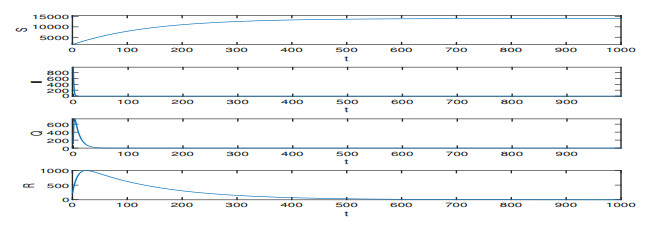

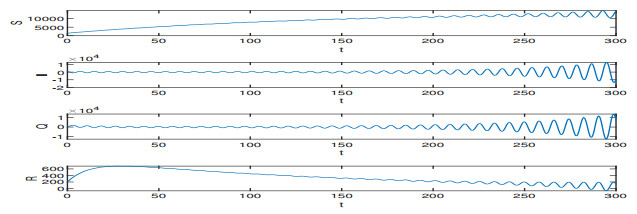
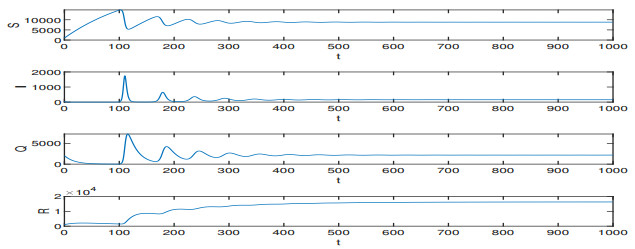
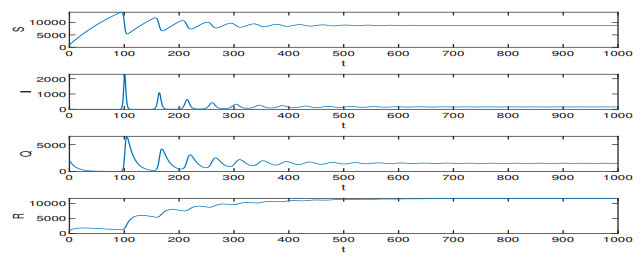
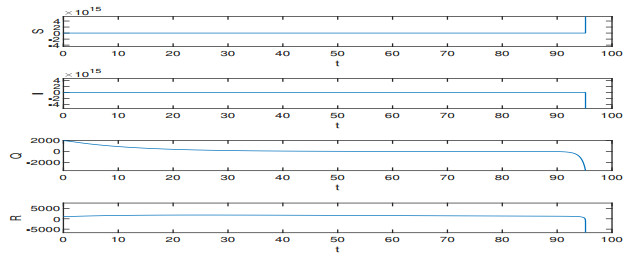


 DownLoad:
DownLoad: